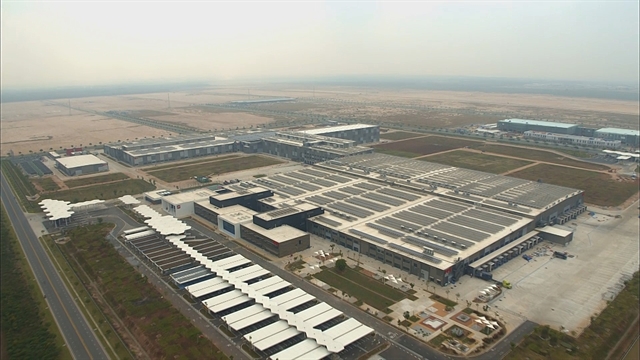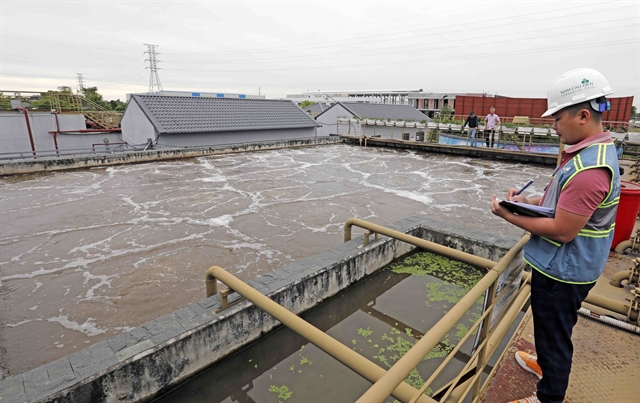 Economy
Economy

 |
| Nguyễn Anh Dương, director of the Department for General Economic Issues and Integration Studies. Photo Courtesy of Nguyễn Anh Dương |
Nguyễn Anh Dương, director of the Department for General Economic Issues and Integration Studies, talks with Việt Nam News reporter about impacts of businesses' ESG practices on the process of the country's circular economy development and what circular economy policies mean to ESG practices.
What is the rationale for the Circular Economy Development Project in Việt Nam which was approved by the Prime Minister in Decision 687/QĐ-TTg on June 7 last year?
Circular economy has evolved in Việt Nam for decades, albeit in very simple forms (so-called VAC, VACR, etc.). Law on Environmental Protection 2020 and Decree 08/2022/NĐ-CP dated January 10, 2022 detailing a number of articles of the Law were the first legal documents that officially mentioned the concept, criteria, roadmap and mechanisms to encourage the development of circular economy. However, these regulations do not clearly demonstrate the economic mechanisms and benefits of the circular economy model, such as the ability to generate added value, promote innovation and foster linkages among industries and businesses, as well as increase productivity and income for workers. In addition, established policies and regulatory framework to create conditions for circular economic development in the medium and long term have not been sufficiently enabling.
For these reasons, the Prime Minister issued Decision 687/QĐ-TTg dated June 7, 2022 approving the Circular Economy Development Project in Việt Nam. The Decision emphasises the approach focusing more directly and more specifically on the economic benefits of circular economy models. With that approach, the Decision highlights the necessity of promulgating long-term policies to encourage and facilitate circular economy development, associated with specific roadmaps and results. These policies will serve as solid legal basis for sectors, industries and localities to take initiatives promoting circular economy models in a flexible, adaptive and responsive manner.
Since then, what have ministries and localities been doing to implement the project?
To date, a number of ministries, agencies and localities have been working on action plans to implement the assigned tasks in the Law on Environmental Protection and Decision 687. Some localities have already issued plans to implement Decision 687/QĐ-TTg (such as Cà Mau); proactively studying topics and projects on circular economy (Hà Nội, Đà Nẵng, Huế, etc.); working on waste management and environmental protection policies in some localities; and actively disseminating information to raise public awareness of the circular economy and its benefits.
Regulatory efforts are on-going. The Ministry of Planning and Investment has chaired and coordinated with ministries, agencies and localities to develop a decree on Regulatory Sandbox for Circular Economy, and has been gathering public comments.
The Ministry of Natural Resources and Environment is working, in collaboration with government agencies and localities, on a draft national action plan for the circular economy.
The Ministry of Agriculture and Rural Development is drafting a project for scientific development and application and technology transfer to promote circular economy in agriculture until 2030.
What are the challenges and shortcomings in the process of developing the circular economy in Việt Nam?
Regarding the institutional framework: Việt Nam does not have an official taxonomy for green economy, and the criteria for development of circular economy in particular. For instance, the content of roles, benefits and criteria of circular economy in agriculture are unclear, or even non-existent.
Việt Nam also has not established a database system covering life cycle of a product from production to consumption. This limitation makes it difficult to assess the level and the extent of readiness in developing circular economy in various sectors and localities.
Việt Nam still faces market-based difficulties in both production and consumption stages in the circular economy. Developing the input material market requires that waste be converted into valuable goods used as input materials and their quality must be good enough for reuse. On the other hand, Việt Nam does not have a strong enough supporting industry for recycling activities. In this regard, Việt Nam remains short of resources for recycling such as capital, highly qualified human resources, specialised equipment and the ability to master new technology.
Regarding the output market, Việt Nam still awaits mechanisms and policies to promote the consumption of products from recycled waste. Furthermore, the quality of products using recycled materials remains at an average or low level. Few recycled products are of high quality, or those of high quality also have high prices.
Awareness of the circular economy and the need to develop a circular economy model is still limited. In particular, the circular economy requires classification and cleaning of waste before being reused and recycled, which is also a big challenge due to people's low awareness of waste classification at the source. Meanwhile, we are short of communication to help improve the understanding of the circular economy.
Last, the majority of Vietnamese businesses are small and medium-sized enterprises (SMEs), with very limited technological capacity to recycle and reuse, not to mention the capacity to contribute to the recovery of natural resources. As a popular concern, there are very few links among SMEs or between SMEs and large-scale enterprises. Developing a circular economy centred on SMEs and their inter-firm linkages is thus no easy task.
 |
| A wastewater treatment plant in Nam Cầu Kiền Industrial Zone in Thủy Nguyên District, northern port city of Hải Phòng. The IZ has set a target to reach zero carbon emissions by 2030 by transforming itself into an eco-industrial model. — VNA/VNS Photo Trần Việt |
What does businesses' ESG practice mean in addressing the above challenges?
Shifting towards sustainable development and doing business responsibly have become global trends. Under this circumstance, the application of ESG (Environment, Society and Governance) standards to production and business activities becomes vital for Vietnamese enterprises. I think the enterprises should take a friendlier view. ESG is not solely for compliance. ESG practices can help businesses better manage risks, improve business position, reduce operating costs and increase access to investment capital sources.
On the other hand, implementing ESG to realise production and business targets in a sustainable way means getting economic benefits without compromising environment pollution and social welfare. It is a development path in the direction towards the circular economy. As many partners have issued regulations related to carbon taxes, reducing carbon emissions has become a challenge for businesses. Accordingly, businesses need to redesign their production and business models, build a business roadmap and strategy in the direction of reducing the exploitation of natural input materials, increase the use of renewable energy sources and focus on training human resources. Being able to work on ESG disclosure and follow-up actions also means that enterprises are already ahead of other competitors.
According to Decision 687, the Prime Minister assigned the Ministry of Planning and Investment to develop a decree on a Regulatory Sandbox for Circular Economy. In your opinion, when this decree takes effect, how will it impact the ESG practices of businesses?
While long-term revisions of laws and regulations are necessary for the circular economy, enterprises cannot wait. The Decree thus aims to provide a pilot mechanism for circular economy development, to encourage investors and businesses to quickly realize circular economy ideas and initiatives, and at the same time contribute to green transition and green recovery in Việt Nam. In addition, the results of the implementation of the Decree will serve as a practical foundation for improving the legal framework for the circular economy in Việt Nam.
When the decree is issued and appropriate policy incentives take effect, enterprises will leverage their initiatives to invest in circular economy projects in a number of areas such as agriculture, forestry and fisheries, industry, energy and construction materials. These sectors already offer a broad space and lots of potential, which enables and rewards creativity, innovation and entrepreneurship at the enterprise level. Only on that ground can enterprises stay committed to their ESG implementation plans.
Could you share some international experiences and practices that have been and are probably being applied in Việt Nam towards green and sustainable development?
From our review of policy actions in other countries, some lessons can be drawn as follows:
High political will and openness towards promoting “economic benefit” of circular economy are crucial. There should be a comprehensive approach to the circular economy on a national level, from which the legal framework system to develop the circular economy will be improved.
Promoting corporate social responsibility (CSR) is also necessary. Developing regulations to enforce CSR is important, but may not be the first step. Again, the enterprises need to be incentivised and clearly communicated in terms of their roles and contributions in a green transition, including via the circular economy. Developing a platform where enterprises can share their experiences and seek policy support would be ideal.
Challenges and opportunities related to the transition to a circular economy will vary depending on differences in the development stage, natural resources and political institutions of each country. Developing the circular economy should not be done uniformly for the whole economy, but instead focus on several priority, key areas. While these areas vary from country to country, a common requirement is to develop strong governance frameworks to minimise health and environmental risks from poor management of production and business operation.
Finally, international cooperation plays a very important role. Developing the circular economy requires discussing and sharing experiences and difficulties in the most open way. It is also important to align international cooperation at the G2G level with the B2B cooperation. Underlying that approach is the strong partnership between government agencies and the business community, so that we could identify the areas where international cooperation can quickly deliver good outcomes. — VNS




